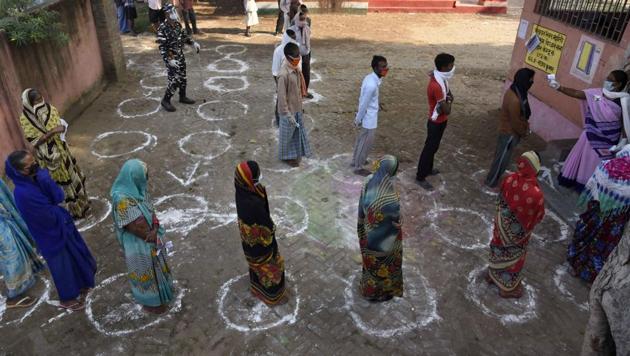In focus: Bihar’s Covid challenge
Bihar Assembly Election 2020: As the verdict on the election of the next government in the state is scheduled for Tuesday, we take a look at the challenges that face the next ruling dispensation.
Images of campaigning in Bihar have suggested scant regard for what continues to be a raging Covid-19 pandemic. An HT analysis and expert views suggest that Bihar’s dubious testing strategy and poor medical infrastructure, combined with the time lag that could exist between a spread in infections and showing up of actual cases, could make it difficult to ascertain the impact of the polls on the pandemic. As the verdict on the election of the next government in the state is scheduled for Tuesday, we take a look at the challenges that face the next ruling dispensation.

Bihar has been showing a fall in cases and positivity rate
The number of daily new Covid-19 cases in Bihar has been decreasing for more than two months after hitting a peak of over 4,000 new infections on August 11. It has reported only about 500 new cases per day on average recently. Bihar has also seen a big increase in the number of tests conducted. It has conducted more than11 million Covid-19 tests, second to only Uttar Pradesh. In terms of tests per million people, Bihar stood behind 31 states and union territories by the end of August, when it had conducted 4,586 tests per million people, nearly a fourth of the national average.
Click here for full coverage of Bihar Assembly Election 2020
By the end of October, Bihar had tested 88,941 per million people, higher than the national average of 86,325, and now behind only 19 states. The growth in the number of tests has come with a drop in the positivity rate, which is the share of tests that come positive. It peaked at 17% at the end of July and has been less than 2% for about two months now. The World Health Organization says the positivity rate from a region that has a comprehensive testing programme should be at or below 5% for at least two weeks before it can be considered that the outbreak is under control.
But its testing strategy is dubious
While the headline numbers on Bihar’s Covid-19 situation suggest that the situation is under control, the actual picture could be worse. Bihar’s testing strategy has been characterised by a big reliance on rapid antigen tests, which comprise nearly 90% of the Covid-19 tests conducted in the state. On any given day in September and October, rapid antigen tests had a share of anywhere between 81%-92% of the total tests conducted. Rapid antigen tests are less reliable because they are significantly more likely to throw up false negatives – infected persons showing up as uninfected – for people who are infected with low viral load.
Also read | Bihar polls: People will send message that jobs, inflation key issues, says P Chidambaram
According to the Harvard Medical School, the reported rate of false negatives in antigen tests could be as high as 50%. A Reverse Transcription-Polymerase Chain Reaction (or RT-PCR) test is seen as the gold standard in Covid-19 testing. But RT-PCRs are more time-taking and expensive. A share of rapid antigen tests is bound to bring down positivity rates, while the RT-PCR tests tend to result in a higher positivity rate. This holds for Bihar as well.
Bihar fares the worst in health care infrastructure
According to data shared by the government in September during the monsoon session of Parliament regarding Covid-19-related health care infrastructure, Bihar had the lowest number of isolation and intensive care unit beds per million people in India. Bihar is a laggard in terms of patients seeking treatment and registration of deaths, which makes it less likely to detect infections in hospitals. According to the latest Sample Registration System data (for 2018), 32% people who died in Bihar had received medical treatment before death, the lowest in India. About 35% of deaths in Bihar are registered. This, too, is the lowest in India. There is a medically certified cause of death in only 13.6% of the registered deaths in Bihar.






